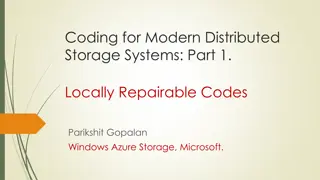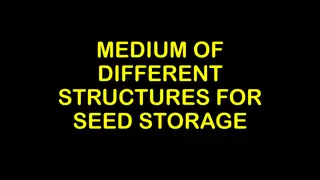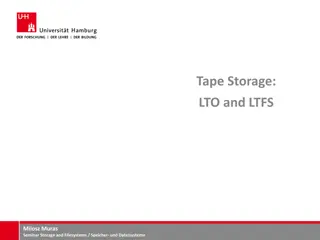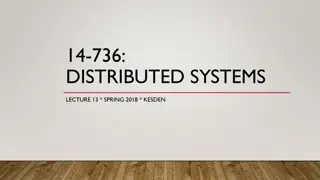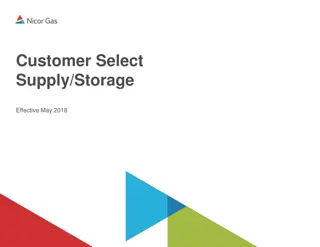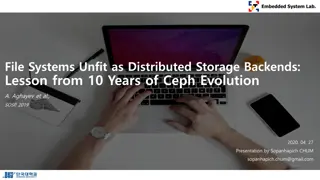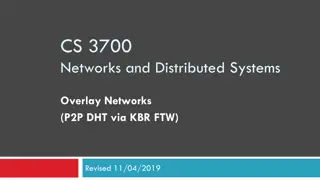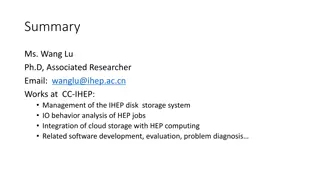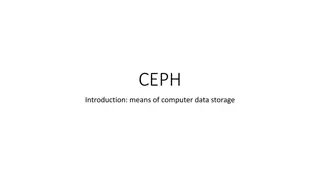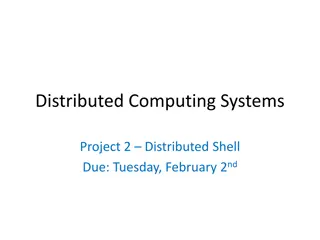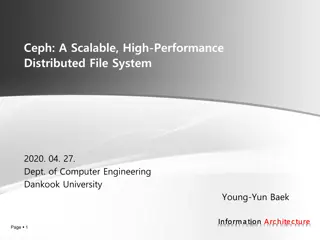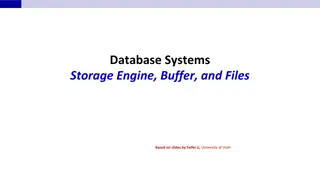BigTable - Efficient Distributed Data Storage
BigTable is a distributed, fault-tolerant system designed to handle massive amounts of structured and semi-structured data efficiently. It supports high read/write rates, efficient scans, and dynamic server management. Built on a multi-level map structure, BigTable is capable of managing terabytes of in-memory and petabytes of disk-based data across thousands of servers. Its design allows for asynchronous updates, access to real-time data, and support for complex data operations such as joins and data change tracking over time.
Download Presentation

Please find below an Image/Link to download the presentation.
The content on the website is provided AS IS for your information and personal use only. It may not be sold, licensed, or shared on other websites without obtaining consent from the author.If you encounter any issues during the download, it is possible that the publisher has removed the file from their server.
You are allowed to download the files provided on this website for personal or commercial use, subject to the condition that they are used lawfully. All files are the property of their respective owners.
The content on the website is provided AS IS for your information and personal use only. It may not be sold, licensed, or shared on other websites without obtaining consent from the author.
E N D
Presentation Transcript
BigTable Danyang Zhuo Duke University Some materials are from Jeff Dean s Bigtable slides
Why BigTable? Lots of (semi-)structured data at Google URLs: Contents, crawl metadata(when, response code), links, anchors Per-user Data: User preferences settings, recent queries, search results Geographical locations: Physical entities shops, restaurants, roads Scale is large Billions of URLs, many versions/page - 20KB/page Hundreds of millions of users, thousands of queries/sec Latency requirement 100+TB of satellite image data
Why not use commercial DB? Scale is too large for most commercial databases Even if it weren t, cost would be very high Building internally means system can be applied across many projects for low incremental cost Low-level storage optimizations help performance significantly Much harder to do when running on top of a database layer
Goals Want asynchronous processes to be continuously updating different pieces of data Want access to most current data at any time Need to support: Very high read/write rates (millions of ops per second) Efficient scans over all or interesting subsets of data Efficient joins of large one-to-one and one-to-many datasets Often want to examine data changes over time E.g. Contents of a web page over multiple crawls
BigTable Distributed multi-level map With an interesting data model Fault-tolerant, persistent Thousands of servers Terabytes of in-memory data Petabyte of disk-based data Millions of reads/writes per second, efficient scans Self-managing Servers can be added/removed dynamically Servers adjust to load imbalance
Background: building blocks Google file system (GFS): raw storage Scheduler: schedule jobs onto machines Lock service : distributed lock manager MapReduce: large-scale data processing GFS: stores persistent state Scheduler: schedules jobs for BigTable serving Lock service: coordinator election, location bootstrapping Mapreduce: used to read/write BigTable data
BigTable Overview Data model Implementation Tablets, compactions API Refinements locality groups, compression, shared logs, replication
Basic data model Distributed multi-dimensional sparse map (row, column, timestamp) -> cell contents
Rows Name is an arbitrary string Access to data in a row is atomic Row creation is implicit upon storing data Rows ordered lexicographically Rows close together lexicographically usually on one or a small number of machines
Question Why URL is stored in the reversed ordering?
Tablets Large table broken into tablets at row boundaries Tablet holds contiguous range of rows Clients can often choose row keys to achieve locality Aim for ~100MB to 200MB of data per tablet Serving machine responsible for ~100 tablets Fast recovery 100 machines each pick up 1 tablet from failed machine Fine-grained load balancing Migrate tablets away from overloaded machine Coordinator makes load-balancing decisions
Locating tablets Since tablets move around from server to server, given a row, how do clients find the right machine? Need to find tablet whose row range covers the target row One approach: could use the BigTable coordinator Central server almost certainly would be bottleneck in large system Instead: store special tables containing tablet location info in BigTable cell itself
Locating tablets Our approach: 3-level hierarchical lookup scheme for tablets Clients cache tablet locations
Tablet representation SSTable: Immutable on-disk ordered map from string->string String keys : <row, column, timestamp> triples
Googles SSTable format An SSTable provides a persistent, ordered immutable map from keys to values, where both keys and values are arbitrary byte strings. Internally, each SSTable contains a sequence of blocks (typically each block is 64KB in size, but this is configurable). A block index (stored at the end of the SSTable) is used to locate blocks; the index is loaded into memory when the SSTable is opened.
Compactions Tablet state represented as set of immutable compacted SSTable files, plus tail of log (buffered in memory) Minor compaction When in-memory state files up, pick tablet with most data and write contents to SSTable stored in GFS Major compaction Periodically compact all SSTable for tablet into new base SSTable on GFS
Columns Columns have two-level name structure: family:optional_qualifier Column family Unit of access control Has associated type information Qualifier gives unbounded columns
Timestamps Used to store different versions of data in a cell New writes default to current time, but timestamps for writes can also be set explicitly by clients Lookup options: Return most recent K values Return all values in timestamp range (or all values) Column families can be marked w/ attributes: Only retain most recent K values in a cell Keep values until they are older than K seconds
API Metadata operations Create/delete tables, column families, change metadata Writes (atomic) Set(): write cells in a row DeleteCells(): delete cells in a row DeleteRow(): delete all cells in a row Reads Scanner: read arbitrary cells in a bigtable Each row read is atomic Can restrict returned rows to a particular range Can ask for just data from 1 row, all rows, etc. Can ask for all columns, just certain column families, or specific columns
BigTable coordinator Assigns tablets to tablet servers Detecting and additional and expiration of tablet servers Balancing tablet-server load Garbage collection of files in GFS Handles schema changes Creation of new tables, column families
Locality group Column families can be assigned to a locality group Used to organize underlying storage representation for performance Scans over one locality group are O(bytes_in_locality_group) , not O(bytes_in_table) Data in a locality group can be explicitly memory-mapped
Compression Many opportunities for compression Similar values in the same row/column at different timestamps Similar values in different columns Similar values across adjacent rows Within each SSTable for a locality group, encode compressed blocks Keep blocks small for random access (~64KB compressed data) Exploit fact that many values very similar Needs to be low CPU cost for encoding/decoding
Caching for read performance Scan cache Key-value cache Useful for applications reads the same data repeatdly Block cache Useful for applications that tend to read data that is close to thedata they recently read Both can reduce read traffic from GFS
Bloom filter A read will require SSTable traversal Bloom filter can tell whether a specific key is in the SSTable or not quickly
Shared logs Designed for 1M tablets, 1000s of tablet servers 1M logs being simultaneously written performs badly Solution: shared logs Write log file per tablet server instead of per tablet Updates for many tablets co-mingled in same file Start new log chunks every so often (64 MB) Problem: during recovery, server needs to read log data to apply mutations for a tablet Lots of wasted I/O if lots of machines need to read data for many tablets from same log chunk
Shared log recovery Recovery: Servers inform coordinator of log chunks they need to read Coordinator aggregates and orchestrates sorting of needed chunks Assigns log chunks to be sorted to different tablet servers Servers sort chunks by tablet, writes sorted data to local disk Other tablet servers ask coordinator which servers have sorted chunks they need Tablet servers issue direct RPCs to peer tablet servers to read sorted data for its tablets



